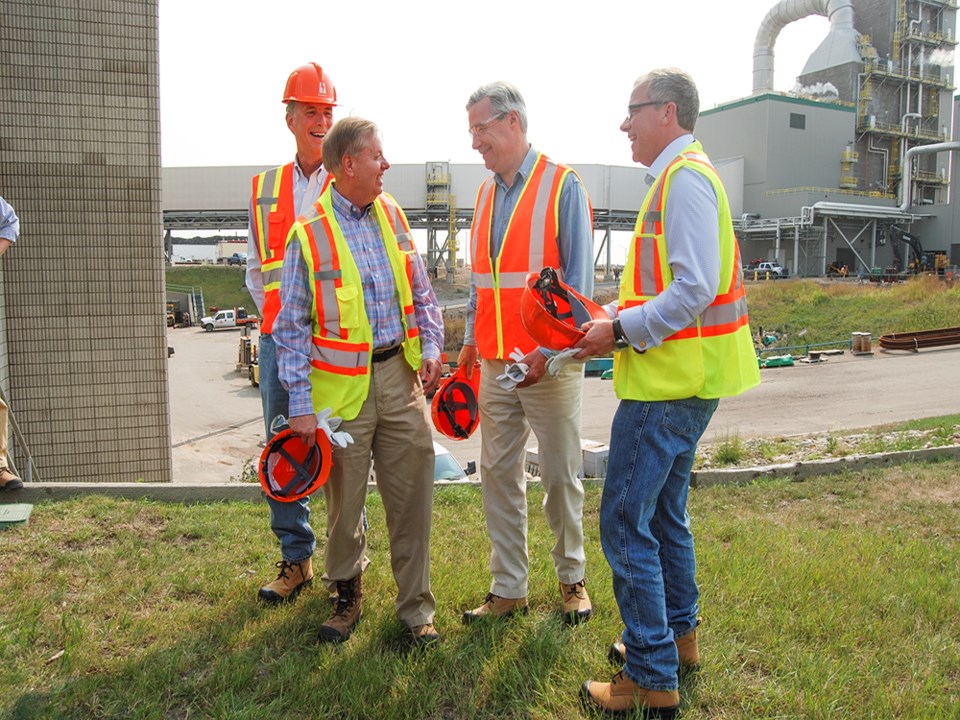Who knew that Saskatchewan could provide the bridge between Republicans and Democrats, America’s avowed political enemies.
But, that thought was expressed and confirmed by a couple of United States Senatorial heavyweights who were visiting Saskatchewan on Aug. 26 to tour the Boundary Dam Unit 3, carbon capture project that is gaining global exposure.
The fact BD3 is working efficiently by collecting over 90 per cent of the post-combustion carbon dioxide emissions as well as the sulphur dioxide, and turning them into value-added products in the oilfield and construction industries, has grabbed the attention of more than a few American government officials and elected representatives.
South Carolina’s U.S. presidential hopeful (Rep.) Sen. Lindsey Graham; Rhode Island (Dem.) Sen. Sheldon Whitehouse and South Carolina (Rep.) Congressman Tom Rice were joined by Sask. Premier Brad Wall for a tour of the carbon capture facility that has been in full operation since October of last year.
“I’ve found the relationship between myself and Saskatchewan growing in importance. Sheldon (Whitehouse) is the leading voice in the Democratic Party on environmental causes above all others,” said Graham who is one of 17 candidates currently seeking the Republicans’ nod to represent them as their presidential candidate.
“I would argue we need to rid our system of coal if we’re going to have the kind of life that human-kind has had for hundreds of generations … unless … technology like this can make coal clean. If it can, then we have a whole new set of opportunities and a much easier political solution. So, it’s really promising and I’m really glad to be here,” said Whitehouse during a media scrum just prior to the tour of Boundary Dam and the CO2 capture island that is hooked up to the power plant’s No. 3 power generating unit that is capable of producing up to 120 megawatts of electrical power. Graham had noted in his opening statement the Saskatchewan project was one that “will attract an unusual coalition. I make a prediction that around this project you’re going to find American policy makers coming together. We’re all going to come up here over time, in larger numbers, regardless of our bias, whether it’s to lower CO2 emissions or become more energy independent by harvesting oilfields for more production. The centre of the debate in Washington is going to gravitate to Saskatchewan,”
“You proved one thing. If you build it, they will come,” said Graham, in response to a media question regarding the importance he placed on the visit. He noted that representatives from over 25 countries have now visited the BD3 plant.
He added that Saskatchewan had proven a concept regarding carbon capture and sequestration and that the United States could learn from what has been carried out in the province.
“You’re going to make money from this facility over time. Sheldon and I have different political views on a lot of things but I’m here to tell you the Republican party is going to become more environmentally sensitive over time or we’re not going to do well. His party is going to become more practical over time, or they’re going to have a problem. The bottom line is that the capturing of CO2 works. It has multiple uses and I want to hear of why we have stopped this in the U.S.” he said, referring to a pilot project that had been launched in Illinois and then halted.
He said he’ll be asking those players who were involved in the Illinois project “why can’t you do what they did in Saskatchewan? I’m a Republican who believes that through CO2 emissions and greenhouse gases, the planet is warming up. I want to argue about solutions. I want a pro-business solution. I want the energy and environmental community to come together to find a way to move this forward in a cost-effective manner. I want clean air, clean water, energy independence,” said Graham “And to create jobs in the process. If you yearn for a cleaner environment, count me in. If you’re worried about energy cost, count me in. I think this is a way to bring both sides together. The reason I like Sheldon so much is that he really is practical. He believes with a passion that climate change is one of the great scourges of mankind. I say the problem is real and I’d like to solve the problem and there’s no way we’re going to solve it unless both of us work together. This may be a bridge between the two sides … this facility,” he said, nodding toward the giant addition to the Boundary Dam Power Station.
Wall said it is his intention to keep the leading legislators in the U.S. advised as to what is happening in Saskatchewan and that there is a way to keep coal in the mix and be a part of a clean energy future in both Canada and the United States.
In his opening remarks, Rice noted coal remains the least expensive and most abundant fuel for power generation and that perhaps the doubt was being removed with regards to that fuel source being unable to meet the demands of the future. “We’re learning it’s not just theory, it’s here in practice in the eyes of the world that are focused on the results. Saskatchewan is leading the way.”
Wall said this was Senator Graham’s third visit to the province, all related to the clean coal concept and the $1.4 billion project. Much of the CO2 being captured continues to be sold to Cenovus Energy for use in their enhanced oil recovery program. The gas that is not used immediately is stored underground in a companion Aquistore sequestration well. The nearby Shand Power Station is home for a test facility where visiting industries and countries are able to perform tests in a controlled power-generating setting.




